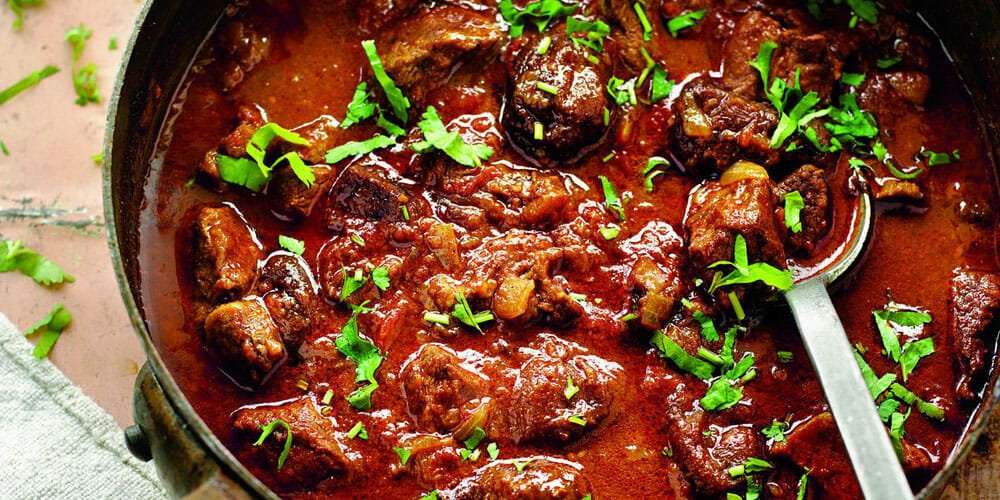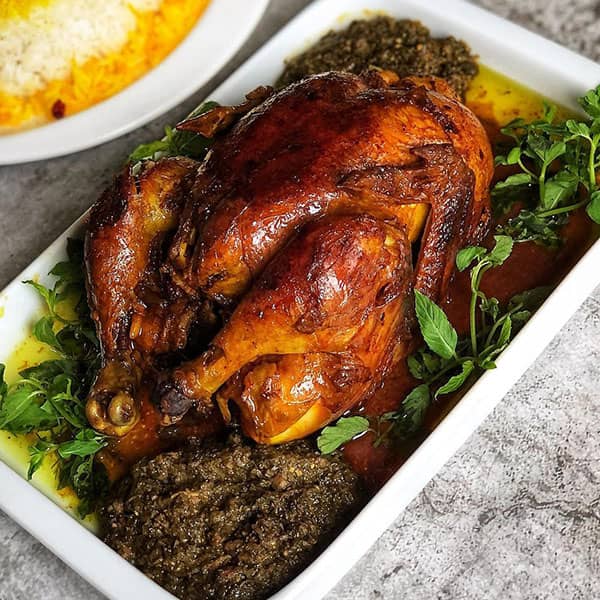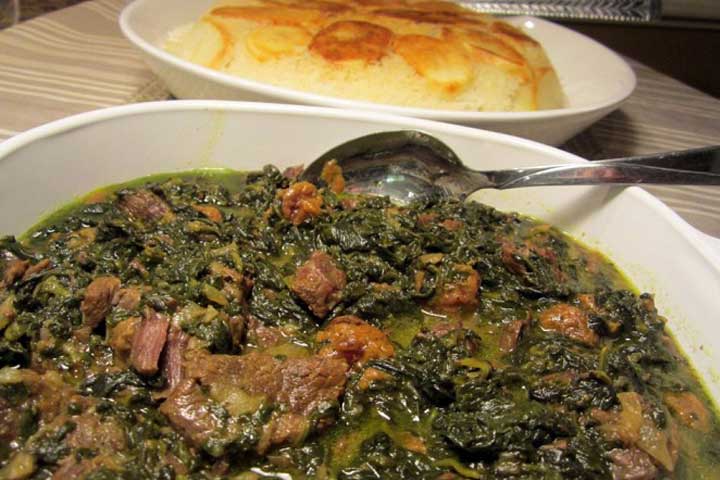Mazandaran, a province in northern Iran, is renowned for its rich and diverse culinary traditions. The region’s cuisine is a delightful blend of flavors, textures, and aromas, reflecting the area’s cultural heritage and natural bounty. From the sweet and sour Khoreshte Alo to the flavorful Morgh Shekam Por, the hearty Tahchin Gosht, the seafood delicacy Malabij, and the comforting Espenasak, each dish tells a story of the region’s history, culture, and natural resources. Whether you’re a food lover or a culinary adventurer, Mazandaran’s cuisine offers a unique and unforgettable gastronomic experience.
Mazandaran Local Foods
Mazandaran, a province in northern Iran, is known for its unique and flavorfullocal cuisine. The dishes are a reflection of the region’s rich cultural heritage and abundant natural resources.
One of the most cherished local foods in Mazandaran is Khoreshte Alo, also known as Plum Stew or Mazandarani chicken and plum. This dish, originating from Sari, a city in Mazandaran, is a delightful blend of sweet and sour flavors. Another local favorite is Morgh Shekam Por, a stuffed chicken dish that’s very popular in Sari. Tahchin Gosht, also known as Beef Tahchin, is another local dish in Mazandaran. It’s a baked rice cake with beef or chicken. Each province in Iran has its own method of cooking this dish, and the version from Mazandaran is particularly delicious.
In addition to these dishes, the cuisine ofMazandaranis heavily influenced by its proximity to the sea, with fish being a staple in many households. Among the vegetable foods, eggplant is one of the most widely consumed. Pomegranate and garlic also have a special place in the region’s cuisine, often used for flavoring food. Foods in Sari are mostly cooked with a sour taste, and people usually use pomegranate paste and sugar to control its taste.
Mazandaran popular dishes
Mazandaran, a province in northern Iran, is renowned for its rich and diverse culinary traditions. The region’s cuisine is a delightful blend of flavors, textures, and aromas, reflecting the area’s cultural heritage and natural bounty. Each dish tells a story of the region’s history, culture, and natural resources. Whether you’re a food lover or a culinary adventurer, Mazandaran’s popular dishes offer a unique and unforgettable gastronomic experience. Some of the most richly diverse cuisine of Mazandaran include:
Khoreshte Alo
Khoreshte Alo, also known as Plum Stew or Mazandarani chicken and plum, is a cherished local dish from Mazandaran, a province in northern Iran.
The stew is made with sliced chicken, plums, sour pomegranate seeds, orange juice, onions, walnuts, and saffron. It’s usually served with rice and garnished with barberry, pistachio slices, and rosemary. The combination of these ingredients creates a unique taste that is both comforting and invigorating. The dish is usually served with rice and garnished with barberry, pistachio slices, and rosemary. The combination of these ingredients creates a unique taste that is both comforting and invigorating. The prunes used in the stew give it a slightly sour flavor. This dish is absolutely lovely and is usually seen in Persian gatherings.
In addition to its delightful taste, Khoreshte Aloo is also known for its numerous health benefits. It’s one of those popular dishes that Iranians prepare for special parties and gatherings.

Morgh Shekam Por
Morgh Shekam Por, also known as Iranian Stuffed Chicken, is a traditional dish that originated in Mazandaran, a province in northern Iran.
The stuffing includes chicken, walnuts, plums, ghee, saffron, barberry, lemon or orange juice, fried onions, sugar, salt, pepper, and herbs such as parsley, coriander, mint, and tarragon. All these ingredients are placed inside the chicken’s stomach and then boiled properly. The result is a flavorful and satisfying dish that is a testament to the region’s culinary creativity. The chicken is usually shortly fried in a pan to obtain its golden color and crunchy skin, and it is then baked in the oven. Iranian stuffed chicken is usually served carved, and each portion should include a piece of moist chicken alongside the fragrant stuffing. The dish is best paired with plain rice, fresh salads, or yogurt.
Morgh Shekam Por is a beloved dish in Iranian cuisine, often served during festive occasions and gatherings. Its origins trace back to traditional Persian cooking, where the use of fruits and spices is celebrated for creating rich and flavorful dishes that reflect the region’s cultural heritage.

Tahchin Gosht
TahchinGosht, also known as Beef Tahchin, is a traditional dish that originated in Mazandaran, a province in northern Iran. Tahchin Gosht is known for its beautiful presentation. When the dish is ready, it is flipped onto a platter, revealing a golden crust of rice on top and layers of meat and rice underneath. The dish is often garnished with barberries, pistachios, or almonds, adding a pop of color and an extra layer of flavor.
This dish is a baked rice cake with beef or chicken. Each region in Iran has its own method of cooking this dish, and the version from Mazandaran is particularly delicious. The dish is usually prepared by layering partially cooked rice with cooked meat (beef or chicken), and then baking it to perfection. The result is a flavorful and satisfying dish that is a testament to the region’s culinary creativity.
The ingredients used in this dish are simple yet flavorful. The rice is first soaked and then partially cooked in a pot of boiling water. The meat, usually beef or chicken, is cooked separately with onions, garlic, and a variety of spices. The partially cooked rice and the cooked meat are then layered in a pot, with the rice forming both the bottom and top layers. The pot is then placed in the oven and baked until the rice is fully cooked and has formed a golden crust.
Tahchin Gosht is not just a dish, but a celebration of flavors. The succulent meat, aromatic spices, and perfectly cooked rice come together to create a dish that is hearty, delicious, and deeply satisfying. Whether served as a main course or a side dish, Tahchin Gosht is sure to impress.

Malabij
Malabij, also known as Malata, is a traditional dish that originated in Mazandaran, a province in northern Iran. Malabij is known for its beautiful presentation. When served, it is often garnished with fresh herbs and accompanied by a side of rice or bread.
This dish is a seafood delicacy that is popular in both Mazandaran and Gilan provinces. It is prepared using white fish, aromatic herbs, walnut kernels, and pomegranate paste. The fish used in this dish is usually a local variety, fresh from the Caspian Sea. The combination of these ingredients creates a unique taste that is both comforting and invigorating.
Traditionally, Malabij is cooked over an open flame or coal, giving it a smoky flavor that enhances the taste of the fish. However, with most households now owning an oven, the preparation of Malabij has become more convenient. The fish is first cleaned and marinated in a mix of aromatic herbs, walnut kernels, and pomegranate paste. It is then grilled over high heat until it is perfectly cooked.
Malabij is usually eaten during dinner and is considered one of the most famous and popular local foods of Sari, a city in Mazandaran. The dish is not only delicious but also nutritious, as it is rich in protein from the fish and healthy fats from the walnuts.
Espenasak
Espenasak, also known as Spinach Stew, is a traditional dish that originated in Mazandaran, a province in northern Iran.
This dish is a delightful blend of meat and vegetables, making it a unique dish that you can hardly resist. Espenasak is the local name of spinach stew in Mazandaran. But its taste is completely different from all the spinach stew you have ever tasted. The ingredients of this food are beef or mutton, garlic leaves, onions, spinach, local vegetables, various spices and water. These ingredients are carefully chosen to create a balance of flavors that is both comforting and invigorating. The dish is usually served with rice and garnished with fresh herbs. The combination of these ingredients creates a unique taste that is both comforting and invigorating. The spinach used in the stew gives it a slightly sour flavor. This dish is absolutely lovely and is usually seen in Persian gatherings.
In addition to its delightful taste, Espenasak is also known for its numerous health benefits. It’s one of those popular dishes that Iranians prepare for special parties and gatherings. Whether you’re a food lover or a culinary adventurer, Espenasak offers a unique and unforgettable gastronomic experience.

Conclusion
The cuisine of Mazandaran, a province in northern Iran, is a delightful blend of flavors, textures, and aromas that reflect the region’s rich cultural heritage and natural resources. From the sweet and sour Khoreshte Alo to the flavorful Morgh Shekam Por, the hearty Tahchin Gosht, the seafood delicacy Malabij, and the comforting Espenasak, each dish tells a story of the region’s history, culture, and natural resources. These dishes are not only delicious but also nutritious, offering a harmonious blend of textures and flavors to delight your taste buds.
Read More